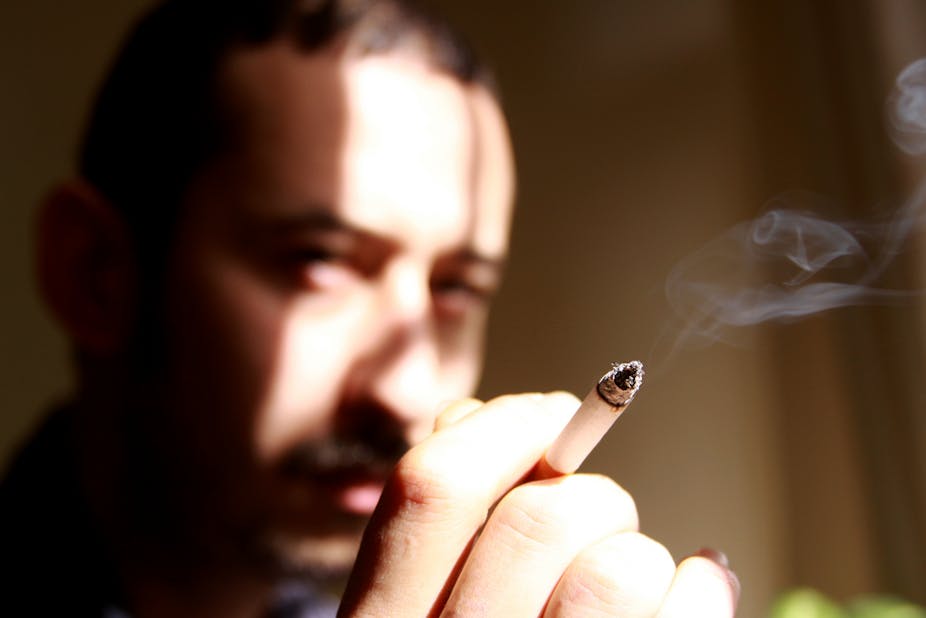From May next year, Queensland prisoners will no longer be able to smoke cigarettes. Smoking in cells was prohibited in Queensland facilities in 2008, but as of next year the prohibition will extend to all prison areas and apply to both prisoners and staff.
The Queensland government’s decision follows the Northern Territory’s prison smoking ban, in place since July this year, and similar measures announced recently by Tasmania and New South Wales, which will come into effect in 2015. Internationally, prison smoking bans have been enacted in Canada, New Zealand and the US federal penitentiary system.
The ban is being promoted as a public health measure, to improve the health of this population group. But it’s difficult to overlook the punitive nature of this move and the removal of prisoners’ rights to make this decision for themselves. It’s also unclear whether such a scheme could actually rid prisons of tobacco.
Prisoner health
The health concerns that underlie these regulations are based on some fairly alarming statistics. Worldwide, around four out of five prisoners smoke. In Australia, it’s slightly higher, at 84%. That’s roughly five times the proportion of smokers in the general Australian population.
But it’s worth remembering that specific groups including people of a low socioeconomic status, the Aboriginal community, the unemployed and those with mental illness, among others, are disproportionately represented in the prison system. So tobacco use is well-entrenched for many people before they are incarcerated.
Significantly, smoking rates at time of leaving prison show minimal improvement, hovering around 80%.
The risks of tobacco use are not restricted to active smoking. Exposure to second-hand smoke, for instance, increases the risk of heart disease and lung cancer to non-smokers by some 25% to 30%. This has obvious implications for people living in close proximity with limited opportunity to move to less crowded conditions.
Flow-on effects
If health-related reasons for instituting bans are clear, other related issues are more problematic.
A Queensland prison guard union representative has warned of significant unrest in response to the proposal, citing a marked increase in disturbances among New Zealand prisoners after a ban was instituted there. This has been disputed, and the issue of overcrowding appears to played a significant role in the increased number of incidents shortly after the ban was instituted.

A more likely scenario is that tobacco, like other substances, will become part of the prison contraband trade, and there is evidence that this has been the case in the United States.
Closer to home, New Zealand prisons experienced a sharp rise in contraband tobacco flows and prices in the months immediately following the 2011 ban. Authorities, however, were reportedly able to clamp down on smuggling by tightening restrictions on incoming goods, among other measures.
Prisoner rights
Ethical considerations around a ban form part of a broader, and much contested, debate over prisoners rights. For those who believe prison is meant to be entirely disciplinary and retaliatory, the right of inmates to smoke will be of no consequence.
If concerns about prisoner and human rights are brought into the equation, however, the issue takes on greater importance.
This is not to argue that inmates of correctional institutes should be allowed to smoke as much and wherever they want to, simply because it is a long-standing habit that helps to pass the time. Yet, comprehensive smoking bans that subject the social group with the highest smoking prevalence to restrictions that are not imposed on the general population seem particularly onerous.
A more measured approach would be to allow smoking in designated outdoor areas within prisons. But this seems to have gained little traction.
Towards real reform
If we want to deal effectively with unacceptable levels of smoking prisons, based on health imperatives, we need to first recognise that bans are not the same thing as cessation programs. There is also evidence that bans have limited impacts on smoking rates because of lax enforcement and the ongoing availability of cigarettes.
Perhaps contrary to popular belief, many smokers in prison, like smokers generally, want to quit. A 2013 Australian Institute of Health and Welfare Bulletin reported that almost half of inmates entering prison express a desire to stop smoking; other sources put the figure as high as 70%.

Willingness to stop smoking is an essential component of successful quit smoking efforts. Taking advantage of this such widespread interest in cessation among prisoners will, however, require resources for smoking cessation program including counselling services.
Policy that “denormalises” tobacco use in prisons by reducing availability and implementing designated smoking areas, as opposed to an outright ban, would provide useful context for cessation initiatives.
Finally, including both staff and inmates in the planning phase would be an essential aspect of any successful program to reduce prison smoking rates and improve inmate health.
In the case of Queensland, such an approach seems unlikely given premier Campbell Newman’s tough on crime persona. While Queensland prisoners will be given nicotine replacement therapy patches, this is – at best – a clumsy approach to dealing with the many quit attempts and other subtleties common to successful efforts to stop smoking.

